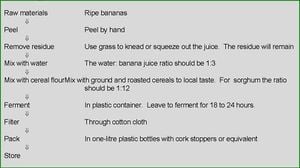
Banana beer is made from bananas, mixed with a cereal flour (often sorghum flour) and fermented to an orange, alcoholic beverage. It is sweet and slightly hazy with a shelf life of several days under correct storage conditions. There are many variations in how the beer is made. For instance, Urwaga banana beer in Kenya is made from bananas and sorghum or millet and Lubisi is made from bananas and sorghum.
Raw material preparation[edit | edit source]
Ripe bananas (Musa spp.) are selected. In the rainy season unripe bananas can be left to finish ripening laid on a hurdle over the fire where the cooking is done. During the dry season bananas can be ripened by making a pit in the ground, covering the sides of the pit with green banana leaves, packing the bananas in to the pit and then covering them with banana leaves and earth. On one side of the pit a little ditch should be dug for a fire so that warmth and smoke can enter the pit. This takes about six days. The bananas should then be peeled. If the peels cannot be removed by hand then the bananas are not sufficiently ripe.
Processing[edit | edit source]
The first step is the preparation of the banana juice. The extraction of a high yield of banana juice without excessive browning or contamination by spoilage micro-organisms and proper filtration to produce a clear product is of great importance. Grass can be used to squeeze the banana so that only a clear juice is obtained. The residue will remain in the grass. One volume of water should be added to every three volumes of banana juice. This makes the total soluble solids low enough for the yeast to act. Cereals are ground and roasted and added to improve the colour and flavour of the final product. The mixture is placed in a container, which is covered in polythene to ferment for 18 to 24 hours. The raw materials are not sterilized by boiling and therefore provide an excellent substrate for microbial growth. It is essential that proper hygienic procedures are followed and that all equipment is thoroughly sterilized to prevent contaminating bacteria from competing with the yeast and producing acid instead of alcohol. This can be done by cleaning with boiling water or with chlorine solution. Care is necessary to wash the equipment free of residual chlorine, as this would interfere with the actions of the yeast. Strict personal hygiene is also essential. For many traditional fermented products, the microorganisms responsible for the fermentation are unknown to scientists. However, there has been research to identify the micro-organisms involved in banana beer production. The main micro-organism is Saccharomyces cerevisiae which is the same organism that is involved in the production of grape wine. However, many other micro-organisms were identified. These varied according to the region of production. After fermentation the product is filtered through cotton cloth.

Packaging and storage[edit | edit source]
Packaging is usually only required to keep the product for its relatively short shelf life. Clean glass or plastic bottles should be used. The product should be kept in a cool place away from direct sunlight.
References and further reading[edit | edit source]
Grape Wine, (Practical Action Technical Brief)
Banana Chips, Practical Action Technical Brief
Traditional Foods: Processing for Profit, Edited by Pete Fellows, ITDG Publications 1997
Useful organizations and contacts
C.T.A
P.O. Box 380
6700 AJ Wageningen
The Netherlands
Telephone: +31 (0) 317 467100
Fax: +31 317 460 067
E-mail: cta@cta.nl
Website: http://www.agricta.org/
Useful internet sites
Horticulture and Landscape Architecture, Perdue University
http://www.hort.purdue.edu/newcrop/morton/banana.html